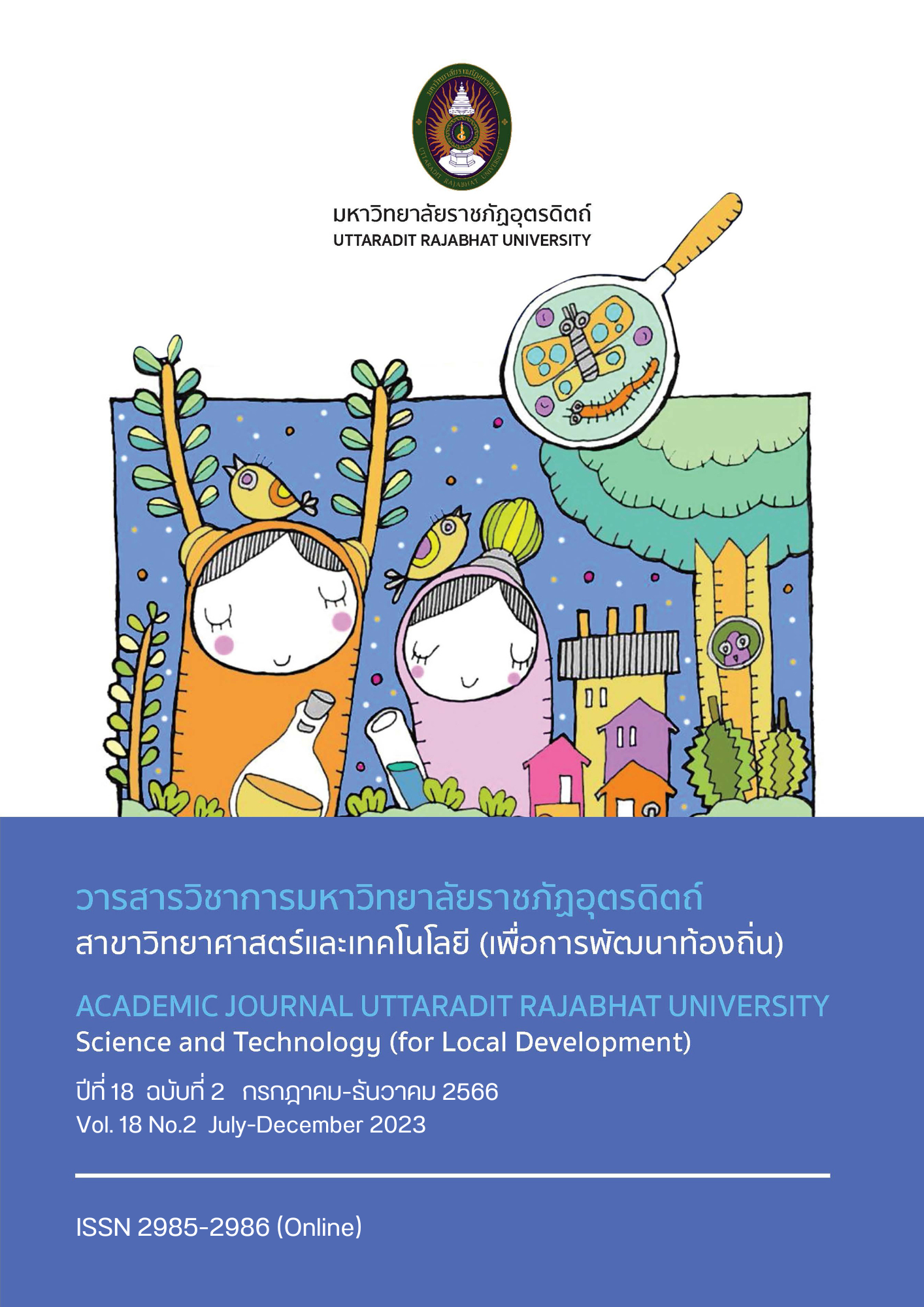DEVELOPMENT OF DROUGHT-TOLERANT RICE BETWEEN LOCAL RICE VARIETIES AND ECONOMIC VARIETIES IN SUPHANBURI PROVINCE
Main Article Content
Abstract
The aim of this study was to develop drought-tolerant rice from local rice varieties together with economic rice varieties in Suphanburi Province by creating 10 mixed pairs using local rice varieties of drought tolerant collected in the area of Suphanburi Province. Two species were selected as the mother species and five economic rice varieties were used as father rice. After that, a new improved rice population was created from the F1 cohort and the rice population was selected by genetic method until getting 10 new lines of improved rice varieties. When tested for drought tolerance in the seedling stage, it was found that rice RHSB1 line had the best drought tolerance. When assessing the level of recovery, it was found that rice RHPT1 line had the best level of recovery after water exposure. As for the yield components of the rice varieties, each parameter was performed with a statistical variance test (ANOVA). It was found that the highest mean height of the mother rice line RH was 166.3 cm. The highest mean of seedlings per hill and panicle per hill was RHPT1 line at 7.33 seedlings per hill and 6.67 panicle per hill, respectively, with the highest average number of seeds per ear, and the highest average weight of 100 filled grains. The maximum average grains weight per panicle (g) was RHSB1 line was 175.3 seeds, 2.63 g, 882.33 g and 20.67 g. As for productivity per rai, Rice of RHSB1 line gave the highest average yield of 818 kilograms per rai while all varieties of new improved rice had different averages. Farmers could choose to use these rice varieties to replace the original rice when drought and water shortage occur to generate income for farmers.
Downloads
Article Details

This work is licensed under a Creative Commons Attribution-NonCommercial-NoDerivatives 4.0 International License.
References
กนกอร เยาว์ดำ, ประภา ศรีพิจิตต์, ธานี ศรีวงศ์ชัย, และสุภาพร จันทร์บัวทอง. (2560). การพัฒนาสายพันธุ์ข้าวต้านทานโรคขอบใบแห้งโยวิธีการผสมกลับและคัดเลือกด้วยเครื่องหมายดีเอ็นเอ. ว. วิทย. มข., 45(3), 595-604.
กรมการข้าว. (2566). องค์ความรู้เรื่องข้าว. สืบค้น 2 กุมภาพันธ์ 2566, จาก https://webold.ricethailand.go.th/rkb3/title-index.php-file=content.php&id=1.htm
ชูศักดิ์ จอมพุก และชัยพฤกษ์ มณีพงษ์. (2539). เทคนิคการผสมข้าวระหว่างข้าวปลูก (Oryza Sativa) กับข้าวป่า (O. mimuta). วารสารวิทยาสารเกษตรศาสตร์ สาขาวิทยาศาสตร์, 30(1), 1-7.
บุญหงษ์ จงคิด. (2545). การศึกษาเปรียบเทียบลักษณะดีอื่น ๆ ทางการเกษตรของสายพันธุ์ข้าวสายพันธุ์ปรับปรุงใหม่ทนแล้งที่ได้จากคู่ผสมระหว่างพันธุ์ข้าวขาวดอกมะลิ 105 และพันธุ์ดอกพะยอม (รายงานการวิจัย). มหาวิทยาลัยธรรมศาสตร์.
พินธ์ทิพภา สนธิสุวรรณกลุ และสวรรยา ธรรมอภิพล. (2562). การปรับตัวของเกษตรกรชาวนาต่อสถานการณ์ภัยแล้ง ในชุมชนบ้านไผ่จรเข้ อำเภอบางเลน จังหวัดนครปฐม. วารสารการจัดการและการพัฒนา มหาวิทยาลัยราชภัฏอุบลราชธานี, 6(2), 1-22.
พิเชษฐ นาเมือง, สำราญ พิมราช, และเหล็กไหล จันทะบุตร. (2560). การเจริญเติบโต ผลผลิต องค์ประกอบผลผลิต และลักษณะทนแล้งต่อการขาดน้ำในช่วงต้นฤดูปลูกของข้าวพื้นเมือง. วารสารเกษตรพระวรุณ, 14(1), 10-21.
นันทกา แสงจันทร์, ทิพย์วรรณ นันใจยะ, และอัษฎาวุธ แสงจันทร์. (2561). ฐานข้อมูลเพื่อการวางแผนพัฒนาการเกษตรและสหกรณ์รายสินค้าของจังหวัดสระบุรี “ข้าว”. สืบค้น 2 กุมภาพันธ์ 2566, จาก https://www.opsmoac.go.th/saraburi-dwl-files-412791791797
วราภรณ์ แสงทอง, ศิรินภา อ้ายเสาร์, อนุชิดา วงศ์ชื่น, และศรัณย์ จีนะเจริญ. (2564). การทดสอบผลผลิตของสายพันธุ์ข้าวสังข์หยดพัทลุง ที่ไม่ไวต่อช่วงแสง ต้นเตี้ย ข้าวเจ้าและข้าวเหนียว มีกลิ่นหอม สีแดง มีคุณค่าทางโภชนาการสูง. รายงานการประชุมวิชาการระดับชาติ ประจำปี 2564 วันที่ 24-25 ธันวาคม 2564 (น. 701-709). สำนักวิจัยและส่งเสริมวิชาการการเกษตร มหาวิทยาลัยแม่โจ้.
สำนักงานพัฒนาวิทยาศาสตร์เทคโนโลยีแห่งชาติ. (2564). 3 ทศวรรษ สวทช. กับการขับเคลื่อนประเทศด้วยวิทยาศาสตร์และเทคโนโลยี: เกษตรและอาหาร. สำนักงานพัฒนาวิทยาศาสตร์เทคโนโลยีแห่งชาติ. แปลน พริ้นท์ติ้ง.
สำนักงานเศรษฐกิจการเกษตร. (2563, 28 มกราคม). เร่งมาตรการรับมือ ‘ภัยแล้ง’ สศก. แนะ เกษตรกรปลูกพืชทางเลือก ใช้น้ำน้อย. สืบค้น 24 เมษายน 2564, จาก https://www.oae.go.th/view/1/รายละเอียดภาวะเศรษฐกิจการเกษตร/33355/TH-TH
อริศรา เหง้าชัยภูมิ, ธนัชยา เกณฑ์ขุนทด, ประณต มณีอินทร์, กษิดิ์เดช อ่อนศรี, กันตนา หลอดทองหลาง, เกศินี ศรีปฐมกุล, และอภิเดช เอมเอี่ยม. (2565). ผลของอาหารสังเคราะห์สูตร Murashige and Skoog (1962) ดัดแปลงร่วมกับปุ๋ยไฮโดรโปรนิกส์ RSUS1 ต่อการเพาะเลี้ยงเนื้อเยื่อกัญชา. ใน การประชุมวิชาการระดับชาติ วิทยาศาสตร์ วิศวกรรมศาสตร์ เกษตรศาสตร์และเทคโนโลยี มหาวิทยาลัยราชภัฏมหาสารคาม ครั้งที่ 2 (น. 1). มหาวิทยาลัยราชภัฏมหาสารคาม.
Farooq, M., Wahid, A., Lee, D.-J., Ito, O., & Siddique, K. H. M. (2009). Advances in Drought Resistance of Rice. Critical Reviews in Plant Sciences, 28(4), 199-217. https://doi.org/10.1080/07352680902952173
International Rice Research Institute. (1996). Standard evaluation system for rice. (4th ed.). International Rice Research Institute.
Jiang, J. & Zhou, T. (2023). Agricultural drought over water-scarce Central Asia aggravated by internal climate variability. Nature Geoscience, 16, 154–161. https://doi.org/10.1038/s41561-022-01111-0
Joshi, R., Wani, S. H., Singh, B., Bohra, A., Dar, Z. A., Lone, A. A., Pareek, A., & Singla-Pareck, S. L. (2016). Transcription factors and plants response to drought stress: current understanding and future directions. Frontiers in Plant Science, 7, 1029. https://doi.org/10.3389/fpls.2016.01029
Kim, Y., Chung, Y. S., Lee, E., Tripathi, P., Heo, S., & Kim, K.-H. (2020). Root response to drought stress in rice (Oryza Sativa L.). International journal of molecular sciences, 21(4), 1513, 1-22. https://doi.org/10.3390/ijms21041513
Luo, L., Mei, H., Yu, X., Xia, H., Chen, L., Liu, H., Zhang, A., Xu, K., Wei, H., Liu, G., Wang, F., Liu, Y., Ma, X., Lou, Q., Feng, F., Zhou, L., Chen, S., Yan, M., Liu, Z. ... Li, M. (2019). Water-saving and drought-resistance rice: from the concept to practice and theory. Molecular Breeding, 39 (145), 1-15. https://doi.org/10.1007/s11032-019-1057-5
Mitchell, J. H., Siamhan, D., Wamala, M. H., Risimeri, J. B., Chinyamakobvo, E., Henderson, S. A., & Fukai, S. (1998). The use of seedling leaf death score for evaluation of drought resistance of rice. Field Crops Research, 55(1-2), 129-139. https://doi.org/10.1016/S0378-4290(97)00074-9
Narenoot, K., Monkham, T., Chankaew, S., Songsri, P., Pattanagul, W., & Sanitchon, J. (2017). Evaluation of the tolerance of Thai indigenous upland rice germplasm to early drought stress using multiple selection criteria. Plant Genetic Resources, 15(2), 109-118. https://doi.org/10.1017/S1479262115000428
Panda, D., Mishra, S. S., & Behera, P. K. (2021). Drought tolerance in rice : focus on recent mechanisms and approaches. Rice Science, 28(2), 119-132. https://doi.org/10.1016/j.rsci.2021.01.002
Pantuwan, G., Fukai, S., Cooper, M., Rajatasereekul, S., O’Toole, J. C., & Basnayake, J. (2004). Yield response of rice (Oryza sativa L.) genotypes to drought under rainfed lowlands: 4. Vegetative stage screening in the dry season. Field Crop Research, 89(2-3), 281-297. https://doi.org/10.1016/j.fcr.2004.02.007
Sallam, A., Alqudah, A. M., Dawood, M. F. A., Baenziger, P. S., & Börner, A. (2019). Drought stress tolerance in wheat and barley: Advances in physiology, breeding and genetics research. International Journal of Molecular Sciences, 20(13), 3137, 1-36. https://doi.org/10.3390/ijms20133137


